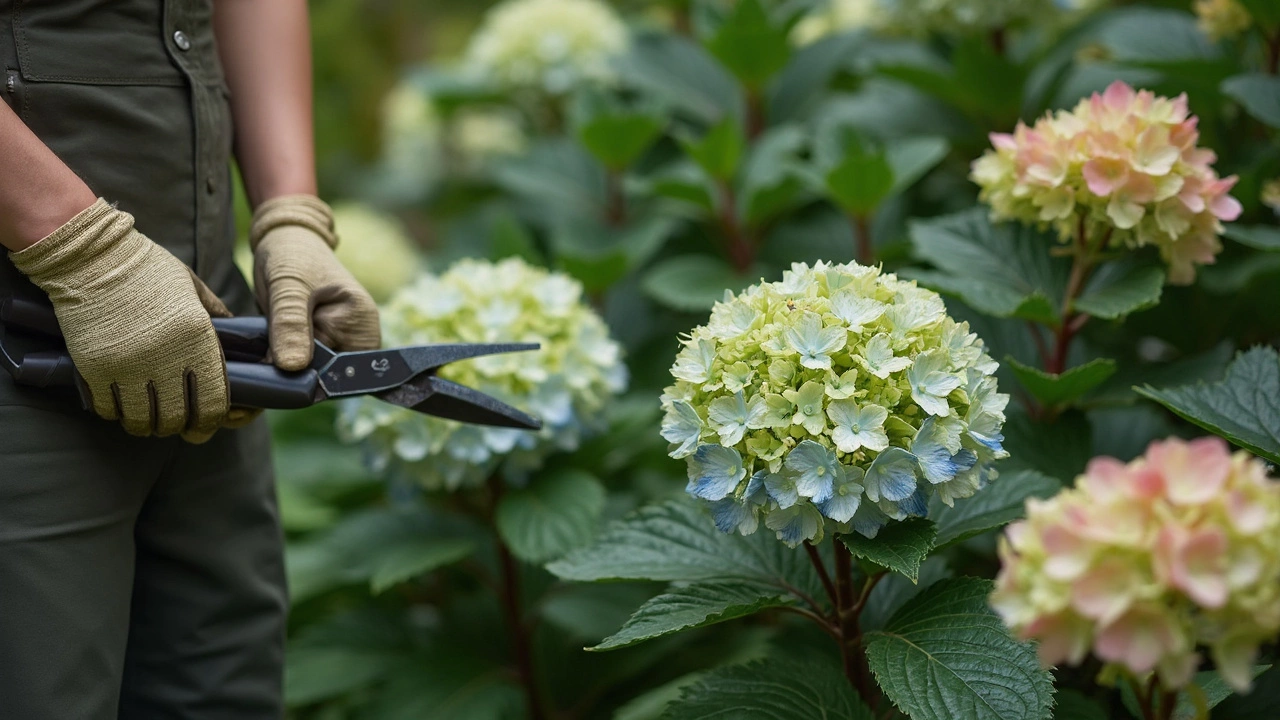Not everyone has the time, or frankly, the energy to fuss over picky plants all summer. So when you see someone’s yard bursting with giant hydrangea blooms, it makes you wonder—is it actually that hard to get those flowers, or are hydrangeas secretly easy to deal with?
Here’s the good news: for a big, dramatic shrub, hydrangeas aren't as needy as you might think. They can handle some mistakes and still show off, as long as you plant them in roughly the right spot. But let’s be real—if you want Instagram-worthy blooms every year, you do need to know a few basics. Skip those, and your plants might sulk instead of showing off.
If you’re shopping for something laid-back for your yard, or you just want to avoid more garden drama, figuring out if hydrangeas match your low-maintenance vibe is a smart move. Let’s get to what really matters—what makes a plant ‘low maintenance,’ how hydrangeas stack up, and the tricks that make them almost take care of themselves.
- What Makes a Plant Low Maintenance?
- The Honest Truth About Hydrangea Care
- Easy Hydrangea Varieties You’ll Love
- Low-Key Hacks for Happier Hydrangeas
What Makes a Plant Low Maintenance?
Let’s cut to the chase: a low maintenance plant is the kind you can plant, forget about half the time, and it’ll still do its job. We’re talking about minimal babysitting—less watering, rare pruning, and not a ton of pest or disease problems. Basically, you want a plant that fits into real life, not one that needs constant pampering.
Here’s what most folks look for when picking something that’s actually easy to care for:
- Doesn’t need a lot of water. If it can handle missed watering sessions, you’re set.
- Stands up to local weather—think rain, heat, or cold snaps.
- Low pest drama. Nothin’ worse than a plant covered in bugs if you miss one spray.
- Can thrive in basic soil, not some extra-special blend.
- Needs trimming just once in a while, not every month.
Check out how these features stack up for typical garden plants:
| Plant Type | Watering Needed | Pruning | Pest Issues | Soil Demands |
|---|---|---|---|---|
| Hydrangea | Medium | Low to Moderate | Low | Adequate |
| Roses | Medium to High | High | High | Rich |
| Hosta | Low to Medium | Low | Low | Average |
| Lavender | Low | Low | Low | Well-drained |
The key thing is how much work you’re willing to do and what your climate throws at you. Some plants just don’t make you sweat over every detail—those are the real keepers. If ‘set it and forget it’ sounds like your style, always check tags or online guides for hints. Look for words like “drought-tolerant,” “disease resistant,” or “hardy.” That’s code for “low hassle.”
The Honest Truth About Hydrangea Care
So, are hydrangeas really as chill as everyone claims? Let’s get totally honest here. If you toss a hydrangea in the ground and walk away, you’ll probably get leaves, maybe a few flowers—but not the big, head-turning blooms you want. Still, compared to roses or needy annuals, they’re not much of a headache once you know what you’re dealing with.
Hydrangeas do the best when you give them three main things: the right spot, regular water (especially the first year), and a little pruning now and then. No fancy fertilizers required, no spraying for bugs every weekend. Give them morning sun and afternoon shade and they’ll usually stay happy.
Here’s a quick rundown on what hydrangeas need—and what you can skip:
- Water: They like moist soil. During summer heat, water deeply once a week. If leaves droop in the heat, add some extra water.
- Soil: Hydrangeas aren’t too picky, but they like well-draining dirt. Amend heavy clay with compost.
- Fertilizer: Once in spring with a balanced, slow-release food does the trick. Skip the complicated stuff.
- Pruning: Some types bloom on old wood, some on new. Know your hydrangea’s variety so you don’t accidentally snip off next year’s flowers.
- Pests: Rarely a problem—deer like them, though. Bugs usually leave them alone.
"Hydrangeas top the list for low-maintenance shrubs in our region. Plant them once, water them until established, and they’ll reward you for years," says Dr. Lisa Eldred Steinkopf, horticulture educator at Michigan State University.
To hammer the point home, check out this handy table:
| Task | How Much Work? | How Often? |
|---|---|---|
| Watering | Medium (first year) | Weekly, more in hot spells |
| Fertilizing | Easy | Once a year |
| Pruning | Depends on variety | 1x per year (if at all) |
| Pest Control | Low | Rarely needed |
| Winter Prep | Easy | Mulch once for protection |
Bottom line? Hydrangeas can be as low maintenance as you want—as long as you start them off right and pay minimal attention to their basics. And when you see those giant blooms every summer, it feels like cheating, compared to fussier plants.

Easy Hydrangea Varieties You’ll Love
A lot of folks think all hydrangeas are the same, but that’s just not true. Some are really picky, while others basically look after themselves. If you want big blooms without a lot of hassle, picking the right type matters way more than you think.
Here are the easiest kinds you can grow, even if you’ve killed other plants before:
- Hydrangea arborescens (Smooth Hydrangea): This one is best known for the classic ‘Annabelle’ variety. It’s even called “foolproof” by lots of garden centers. Tough as nails, it tolerates full sun or part shade, and handles cold winters like a champ. You don’t have to freak out about when to prune, because it flowers on new wood—just cut it back in early spring and you’re set.
- Hydrangea paniculata (Panicle Hydrangea): If you want something you can almost forget about, this is the one. Varieties like ‘Limelight’ and ‘Little Lime’ bloom like crazy, even when you’re not paying attention. They can handle more sun and don’t whine during a dry spell. Plus, they’re less likely to get hit by diseases that mess up other types.
- Hydrangea quercifolia (Oakleaf Hydrangea): This one’s a bit of a show-off in fall with its red leaves. It also does well in shade. ‘Snow Queen’ and ‘Alice’ are some of the no-fuss favorites and rarely need more than a little trim.
Some fancy hydrangeas, like bigleaf (Hydrangea macrophylla), have cool blue or pink flowers but can be finicky. If you’re all about low maintenance, skip those unless you love a challenge.
| Type | Sun/ Shade | Notable Varieties | Maintenance Level |
|---|---|---|---|
| Smooth (arborescens) | Sun/Part Shade | Annabelle, Incrediball | Very Low |
| Panicle (paniculata) | Sun/Part Shade | Limelight, Little Lime | Very Low |
| Oakleaf (quercifolia) | Part Shade | Snow Queen, Alice | Low |
If you pick one of these, you’ll spend less time worrying and more time enjoying big, awesome flowers. Just plant them in the right spot and don’t overthink it.
Low-Key Hacks for Happier Hydrangeas
If you're into hydrangeas but don't want them taking over your weekend, there are some smart shortcuts you can use to keep them looking awesome with barely any stress. Most people overcomplicate things, but these are the hacks you actually need.
- Water Deeply—but Not Constantly: Hydrangeas like moisture, but they don't love being soggy. A deep soaking a couple of times a week is better than light watering every day. In summer, mulching can easily cut down how often you need to drag out the hose.
- Mulch Is Your Friend: Spread 2-3 inches of mulch around the base. Use stuff like wood chips or shredded bark. This helps lock in water and keeps the soil cooler so you can get away with less work.
- Pick the Right Spot: Hydrangeas do best in morning sun and afternoon shade. Too much blazing hot sun is a disaster. If your yard is full sun, panicle and smooth hydrangeas handle it better than the fancy blue bigleaf kind.
- Pruning? Relax: Forget complicated pruning charts—just snip off dead wood in early spring. If you have smooth or panicle types, you can trim more aggressively. Bigleaf and oakleaf are touchier, so just tidy them up.
- Don’t Freak About Soil pH: Hydrangea color changes with soil pH, but honestly, unless you’re chasing the perfect shade of blue or pink, you don’t have to fuss with this. Most folks just enjoy whatever color shows up.
Here's a quick table to help you remember the basics for mostly hands-off care:
| Task | How Often | Extra Tip |
|---|---|---|
| Deep watering | 1-2 times/week | More during heat waves |
| Mulching | Spring (once) | Top up if it looks thin |
| Simple pruning | Early spring | Just remove dead stems |
| Fertilizing | Once in spring | Use a balanced, slow-release type |
You don’t need garden degrees or fancy tools. Stick to these hacks and save yourself the hassle. Hydrangeas really do play nice if you set them up right from the start.
